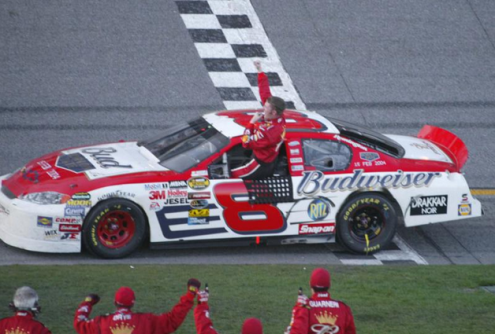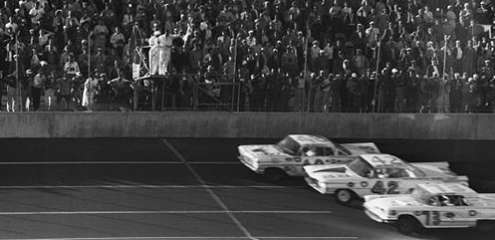
The Most Famous Beach in Racing
February 11th, 2015 by Jaime Baker
In Daytona Beach, Florida lies one of the most historic sites in racing, Daytona International Speedway. In roughly one week, hundreds of sim racers will take to a digital recreation of this historic track for iRacing.com’s Daytona 500 in the NASCAR iRacing Series – Open and Fixed setups. Daytona is home to the most prestigious race on the NASCAR circuit, and has a rich history of great racing. What makes this race so special?
 Founding and Construction: For many years, racing in Daytona Beach meant racing on the Daytona Beach and Road Course, a 3.2 mile (until the late 1940s, where it was extended to 4.2) beach-road combination track. This was until NASCAR founder Bill France Sr. (aka “Big Bill”) envisioned a large paved super-speedway, with incredible banking to maximize the speed of the race cars, and give spectators a better view of the action. 447 acres of land were leased to France by the Daytona Beach city commission next to the Daytona Beach International Airport. The lease required that Big Bill pay $10,000 per year for 50 years. But, backed by Clint Murchison’s $600,000 (from the sale of oil), Pepsi, General Motors designer Harley Earl (whose name appears on the trophy awarded to the winner of the Daytona 500), as well as taking out a second mortgage, France’s vision became a reality, and on November 25, 1957, ground was broken on what would later become known as the World Center of Racing.
Founding and Construction: For many years, racing in Daytona Beach meant racing on the Daytona Beach and Road Course, a 3.2 mile (until the late 1940s, where it was extended to 4.2) beach-road combination track. This was until NASCAR founder Bill France Sr. (aka “Big Bill”) envisioned a large paved super-speedway, with incredible banking to maximize the speed of the race cars, and give spectators a better view of the action. 447 acres of land were leased to France by the Daytona Beach city commission next to the Daytona Beach International Airport. The lease required that Big Bill pay $10,000 per year for 50 years. But, backed by Clint Murchison’s $600,000 (from the sale of oil), Pepsi, General Motors designer Harley Earl (whose name appears on the trophy awarded to the winner of the Daytona 500), as well as taking out a second mortgage, France’s vision became a reality, and on November 25, 1957, ground was broken on what would later become known as the World Center of Racing.
France’s ideas for high banked corners could not be met naturally: There was not enough land outside of the track to support it. To build-up the banking, France’s crew excavated mountains of dirt from the infield. The resulting hole was filled with water and, voila, Lake Lloyd was born. The 29 acre lake in the infield adjacent to the “Daytona Superstretch” has a racing history of its own, having hosted some powerboat races. (Similarly, along with its stock car and sports car racing history, Daytona is also ground zero for motorcycle racing’s annual festival of two wheel competition known as Speedweeks.) But we’re focusing on the car racing, which began a little more than two years after the ground-breaking ceremonies.
The Daytona 500: Automobile racing at Daytona International Speedway began February 6, 1959 with the very first practice session. 16 days later, the inaugural Daytona 500 was held in front of about 42,000 spectators. 200 laps were raced around the 2.5 mile Tri-Oval track for the first time and the finish was one for the history books. Johnny Beauchamp and Lee Petty were battling for the win, when they approached lapped traffic on the final lap. The drivers attempted to pass the car off of Turn 4, coming to the checkered flag. They crossed the stripe three-wide, yet Beauchamp was declared the winner. A photo taken from a fan with perfect timing showed clearly that Petty had crossed ahead of Beauchamp, and on February 25, the Petty-Daytona legacy began when Petty was officially declared the winner. The Petty family has won more Daytona 500s than any other, taking eight of the 56 races as drivers (seven coming from Richard), nine as owners (Petty Enterprises). Hendrick Motorsports is second place on the all-time Daytona 500 teams wins list with eight (including the two most recent races).
The Petty-Beauchamp battle was the start of something great. For the last 56 years, the Daytona 500 has marked the start of the NASCAR Sprint Cup Series season. Though getting-off on the right foot is beneficial, the winner of the 500 rarely goes on to win the NSCS championship. In fact, the Daytona 500 winner has only gone on to win that season’s title eight times in 56 runnings (four times by Richard Petty, two by Jimmie Johnson, and once each by Jeff Gordon and Cale Yarborough). That is a success rate of about 14%. However, nobody really cares whether you won or lost the championship, because you won the Daytona 500.

Daytona has been the scene of highest of highs and lowest of lows for the Earnhardt family and their legion of fans.
The Daytona 500 has been quite emotional for fans the Earnhardt family for almost 20 years now. After many tries, and after coming close so many times, Dale Earnhardt finally visited Victory Lane in 1998. His celebration involved every member of every team on pit road, as they lined up along pit road to personally congratulate the Intimidator. Three years later, while trailing Michael Waltrip and his son Dale Jr. on the final lap, Earnhardt’s car clipped the apron, sending him up the track into Ken Schrader, and the wall. Earnhardt died as a result of the crash, shaking the NASCAR world to its core. Healing began that summer, when Dale Jr. won the Pepsi 400 at Daytona. Three years later, Dale Jr. won the Daytona 500 on an incredibly emotional day for the Earnhardt family, healing the wound a little more.
24 Hours at Daytona: Not only does Daytona kick off the NASCAR season, it also kicks-off the TUDOR United SportsCar Series with the Rolex 24 Hours of Daytona. The event’s roots date back to 1959 when Daytona hosted a six hour/1000 kilometer race won by Count Antonio von Dory and Roberto Mieres. Then in 1962 a three hour race known as the Daytona Continental was held as part of the International GT Manufacturers championship. The race was famously won by Dan Gurney who used the starter motor to coax his Lotus-Climax over the finish line after its engine failed in the waning moments of the race.

Gurney takes the adage “win at the slowest possible speed” to the limit in capturing the 1962 Daytona Continental.
In 1964 the event was expanded to 12 hours before becoming a 24 hour event in 1966, when Ken Miles and Lloyd Ruby took the checkered flag in a Ford GT. Every year since then event (except for 1972 when the race was 6 hours, and 1974 where there was no race) Daytona’s roval has been the site of a 24 hour event despite the fact that, until lights were installed in 1998 to enable the July NASCAR race to run at night, only the stretch of track in front of the pits was illuminated.
Chip Ganassi with Felix Sabates Racing leads all teams in Daytona 24 Hours wins with six (including this year), while Porsche leads in manufacturer wins with 18. iRacing.com was the first online motorsports simulation service to sanction an official 24 Hours of Daytona race a few weeks ago. COANDA SimSport won the inaugural event in the prototype class, while New World SimSport took the GT class.
Daytona 200:Daytona has a “thing” for starting seasons off as, in addition to the Daytona 500 and Rolex 24, the Daytona 200 signals the start of the AMA Pro Racing season. Beginning on the beaches in 1937 and moving to the pavement in ’61, the Daytona 200 has been one of the premier motorcycle races in the United States for nearly 80 years. Ed Kretz wheeled his Indian® motorcycle to the win in the first event held at the 3.2 mile Beach Course, his only win in this race. Roger Reiman won the first Daytona 200 on the speedway in his Harley-Davidson, his first of three Daytona 200 wins.
Tied for most wins in the history of the D200 are Miguel Duhamel and Scott “Mr Daytona” Russell with five. Yamaha have won 22 races and Harley-Davidsons have 16 wins, second on the all time list of winning manufacturers.
The race has experienced controversy over the last few months, as MotoAmerica didn’t schedule the Daytona 200 for the 2015 season. However, on December 1 of last year, the Championship Cup Series agreed to sanction this year’s Daytona 200 scheduled for March 14.
The next chapter in Daytona history will be written by sim racers around the globe starting with the iRacing Daytona 500, the opening round of the 2015 NASCAR iRacing Series. Will you be a part of the story?



















































